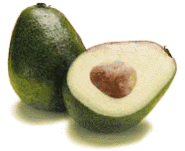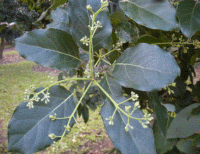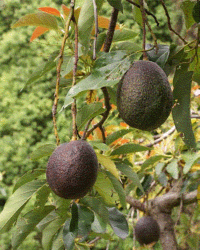 SKC Films Library SKC Films Library |
| SKC Films Library >> Agriculture >> Plant Culture >> Fruit and Fruit Culture |
| Avocado Persea americana, is a member of the Lauraceae (laurel) family. It is often called an alligator pear due to its shape and the color of its skin. The English word avocado is a corruption of the Spanish word aguacate, which itself was a corruption of the Aztec word ahuacatl ("testicle").
Avocados probably originated in southern Mexico, but were being cultivated from the Rio Grande River south into central Peru when the first Europeans arrived. Avocados were introduced into Florida in 1833, and into California in 1856. Today, California accounts for about 90 percent of the world avocado supply, with San Diego County accounting for 60 percent of that supply. Avocados are also grown in Florida and Hawaii, but most trees in those locations are grown by individuals rather than orchards. Seven varities of avocado are grown commercially, but the Hess (or Haas) variety accounts for about 95 percent of the market. The avocado tree is a dense evergreen with alternate, glossy, elliptic, dark green leaves that can grow up to 80 feet in height. The tree grows year-round, with flowers appearing from January through March. The small yellow-green flowers form in bunches of 200-300 on terminal panicles, but only 1-3 fruit will typically be produced per panicle. One avocado tree can produce 500 avocados (200 pounds) per year, but commercially-grown trees typically only produce about 150 avocados (60 pounds) per year. Each avocado can weigh up to 2 pounds. Commercial growers generally harvest their trees by hand from spring through fall, but since the fruit can actually stay on the tree for months after maturing without risk of spoilage or rot some growers may wait for more favorable markets to harvest their crop. avocado flowers avocado tree with fruit Avocados are sodium and cholesterol-free, and one 1-ounce serving only has 4.5 grams of fat and 50 calories. They are also good sources of dietary fiber, potassium, Vitamin E, B-vitamins, and folic acid. The Aztecs used avocados as an aphrodisiac, and leaf and seed extracts were used in a variety of medical applications, including the treatment of diarrhea and dysentery and as an antibiotic. The conquistadors found that a milky liquid obtained from the seeds made an excellent reddish-colored ink, and many documents written in avocado-based ink can still be read today, more than 500 years after they written. OFFICIAL WEBSITE |
| SKC Films Library >> Agriculture >> Plant Culture >>
Fruit and Fruit
Culture This page was last updated on 06/07/2017. |


